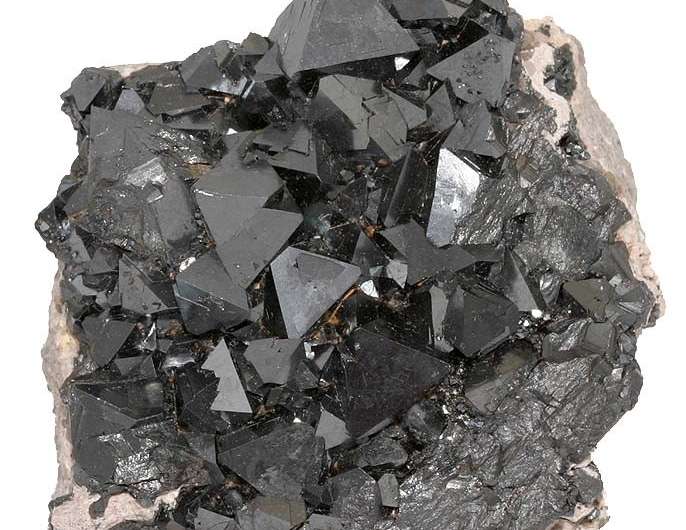Mysterious 'four-dimensional' iron oxide explained

An international group of researchers including Russian scientists from the Moscow State University has been studying the behaviour of the recently-discovered iron oxide Fe4O5. The group has succeeded in describing its complex structure, and proposed an explanation for its very unusual properties. The article appeared in the current issue of the journal Nature Chemistry.
The scientists discovered that when Fe4O5 iron oxide is cooled to temperatures below 150K, it goes through an unusual phase transition related to a formation of charge-density waves—which lead to a "four-dimensional" crystal structure. Artem Abakumov, one of the paper's authors, said that the study of this material would contribute to the understanding of the interconnection between magnetic and crystal structures.
The origins of this research date back to 1939, when the German physicist E.J.W. Verwey first discovered that the iron oxide Fe3O4—commonly known as the mineral magnetite—had a strange phase transition. Magnetite in its normal state is a relatively good electrical conductor, but when cooled below 120K its conductivity markedly decreased, and the material practically became an insulator. Scientists discovered that below 120K, the iron atoms arrange themselves into a kind of ordered structure. In this structure, the electrons cannot move freely within the material and act as charge carriers, and the oxide even becomes a ferroelectric. But the scientists could not explain what exactly changes in the structure, which physicists have spent the last century studying. Researchers guessed that the phenomenon was related to the presence of iron atoms in two different oxidation states (valences)—two and three—and their consequent ability to form ordered structures.
The answer to this question was discovered in 2012, when a group of researchers led by Prof. Paul Attfield of Cambridge University synthesised high-quality magnetite single crystals and deciphered their structure. Scientists showed that, as had been suggested earlier, a so-called change in the ordering had occurred, in which two- and three-valent iron atoms arranged themselves into groups of three, which were called trimerons.
The authors of the article, which has been published in Nature Chemistry, decided to look at different iron oxide, Fe4O5, which has only recently been discovered by an American research team. It's an unusual oxide that can only be formed at extremely high temperatures and pressure—meaning that it is not to be found on the Earth's surface, and exists alongside other oxides containing even greater levels of oxygen, as is now believed, at tremendous depths of hundreds of kilometres below Earth's surface.
When examining the behaviour of this oxide, scientists discovered that it has a phase transition phase very similar to that noted by Verwey in magnetite. It differs, however, in occurring at different temperatures, and the configuration of the structure obtained is much more complex.
"We have found that here, just as in magnetite, when cooling to lower than 150K occurs, an unusual structure evolves. It's something of a mixture between standard charge density waves forming dimers," Artem Abakumov said. "And the situation with the trimerons that was observed in magnetite. This was very complicated in the case of Fe4O5—what's known as a 'incommensurately modulated structure", in which we can't identify three-dimensional periodicity. However, the periodicity can be observed in a higher-dimensional space—in this specific case, in the four-dimensional space. When we mention the four-dimensionality of such structures, we are not actually talking about the existence of these oxides in four dimensions, of course. This is just a technical construct for the mathematical description of such highly complex ordering."
Despite clear similarities between the behaviours of magnetite and Fe4O5, the charge-ordered structure of Fe4O5 remains centro-symmetric, without exhibiting any ferroelectric properties. The special interest that scientists have in Fe3O4 results from the fact that magnetite belongs to a class of materials known as multiferroics—in which two kinds of ordering are seen at the same time, magnetic and electric. If these two different orders become coupled with each other, then the effect of the magnetic field on the material can alter its electric polarization—or conversely, magnetisation changes being affected by electric field.
"If this happens," said Artem Abakumov, "then we get a bifunctional material. That's of interest not only from the fundamental physics viewpoint or solid-state chemistry, but also in terms of how it could be put into practical use. It could be used in sensors—for example, in magnetic field sensors. The only drawback is that normally, coupling of a magnetic and an electrical order is pretty weak, and only appears at low temperatures. Comparative analysis of the crystalline, electronic and magnetic structure of Fe4O5 and magnetite will give us a better shot at studying the relationship of the magnetic and electrical order in these kinds of materials."
More information: Sergey V. Ovsyannikov et al. Charge-ordering transition in iron oxide Fe4O5 involving competing dimer and trimer formation, Nature Chemistry (2016). DOI: 10.1038/NCHEM.2478
Journal information: Nature Chemistry
Provided by Lomonosov Moscow State University


















